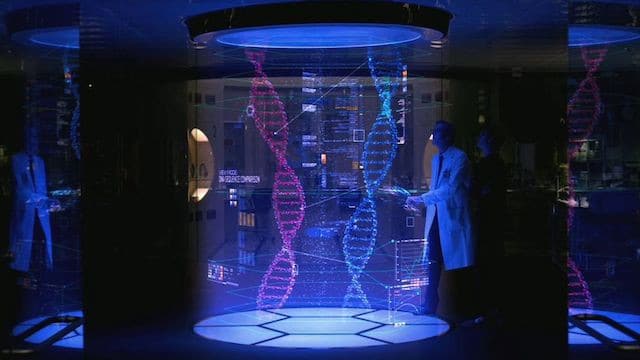
Sony Pictures Entertainment
When Francis Crick and James Watson famously published their article “Molecular Structure of Nucleic Acids: A Structure for Deoxyribose Nucleic Acid” in Nature magazine 61 years ago, they didn’t reveal a discovery of DNA nor did they introduce the concept of genetics to the world. Their main contribution to history (with help from Rosalind Franklin) is in the illustration of the double helix model of DNA, which means they gave us a visual for a science that beforehand was only pictured in an abstract manner.
Is it fair to say the double helix is an iconic image? That’d be like claiming cels and rocks and fire are iconic. DNA is just a part of life, and the double helix is what it looks like. Still, it is in most forms an illustrational icon rather than the real deal, and few sciences have such a distinctly recognizable visual representation, one that has made genetics a very cinematic area of study.
Movies involving experiments and testing involving DNA would still exist without that imagery, but as you can see in the still from The Amazing Spider-Man above, they’re better for having something so easily rendered in CG form. The double helix shows up on computer screens and holographic displays of scientific plans and even in cases where it’s not a literal illustration of DNA, as in the case of the spiral staircase in Vincent/Jerome’s home in Gattaca.
Occasionally DNA itself is depicted, though not always correctly, as in the case of the opening credits sequence of Prometheus and also that scene pictured above. Thanks to The Guardian science desk for pointing out last year how too many people wrongly draw the double helix with a left-handed screw rather than a right.
We tend to only see the visualization of DNA in fiction, especially where something evil or at least unethical is going on – mad scientists and other villains love to show their nefarious schemes almost as much as they love to tell them. And when it comes to fiction movies, DNA is almost always given a bad reputation. It’s the stuff with which monsters are created, whether hybrids and other genetically altered beings or stuff from the past, like in Jurassic Park. Don’t be fooled by the cute portrayal in the video below. Mr. DNA is a bad guy.
While the negative is obvious in movies like Species, Splice and The Island of Dr. Moreau, it can be more complicated. Some viewers might not see the issue with a future in which human genes are modified by the wealthy and therefore instrumental in determining a person’s social class and employment capabilities. Others, however, think of Gattaca as being set in a kind of dystopia. The plot of Code 46 is one of the most complex uses of genetic concepts, as it’s set in another sort of dystopian future where people have to get DNA testing done to see if they’re legally allowed to have sex, meaning they’re not committing incest as a reult to cloning practices and other medical procedures homogenizing the human race.
Thanks to all the movies based on Stan Lee’s creations at Marvel lately, we have a ton of fictional uses of DNA for the superhero genre, and to some degree that’s positive. Mutants in the X-Men movies aren’t an abomination and the worlds of Spider-Man and Captain America are better for their accidental and intended genetic modifications. But before the heroism comes about in the latter two, there’s the initial idea of man playing God, and there’s always a villain crafted from the same genetic cloth. Or a bunch of villains in the case of The Amazing Spider-Man series.
The most positive fictional super-heroic employment of DNA might be in The Fifth Element, where Leeloo’s DNA is compared to human DNA before she’s created through the speedy reconstruction/cloning process. And hey, it looks like they even got the screw direction correct! Look:
There are some nonfiction dramas, too, such as the Hillary Swank movie Conviction, but they might as well be lumped in with the docs because pretty much anything else involving genetics is science fiction involving what ifs. And while the good depictions in docs are on the rise as more and more innocent men and women are freed, we also seem to be getting more and more negatively fantastical depictions in blockbusters.
This summer alone there’s The Amazing Spider-Man 2, X-Men: Days of Future Past, Dawn of the Planet of the Apes, Teenage Mutant Ninja Turtles and I Origins.
Oh, and then there’s a real rarity that opens next weekend called Decoding Annie Parker. This drama is loosely based on a true story in which the lives of a woman with breast cancer (Samantha Morton) and geneticist Mary-Claire King (Helen Hunt) intertwine in an effort to cure cancer by linking it to DNA. This is the kind of movie that does Crick and Watson and the rest of the scientists involved in molecular biology a great service, and if it’s as popular as it is award-winning, maybe we can have more like it.
Check out the trailer for Decoding Annie Parker, which also stars Aaron Paul, Ben McKenzie and Rashida Jones here:
